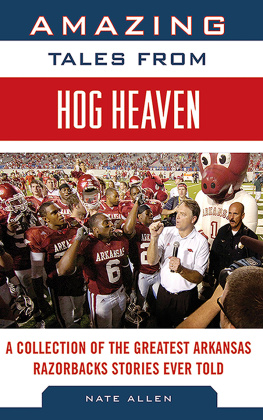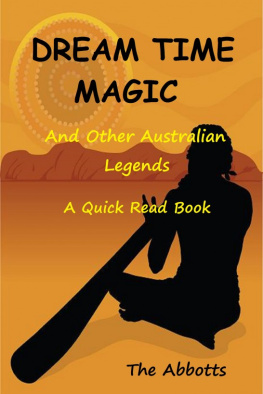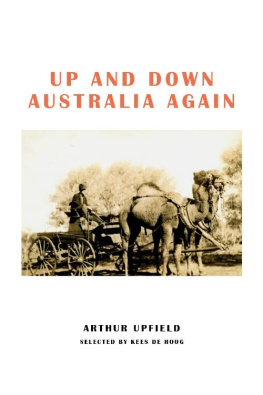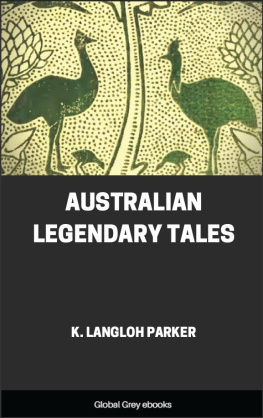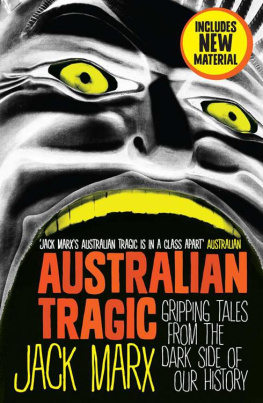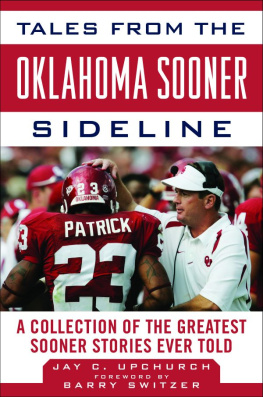Folk-Lore of The Noongahburrahs As Told To The PiccaninniesDedicated To Peter HippiKing of The Noongahburrahs Preface
A NEIGHBOR of mine exclaimed, when I mentioned that I proposed making a small collection of the folk-lorc legends of the tribe of blacks I knew so well living on this station, "But have the blacks any legends?"-thus showing that people may live in a country and yet know little of the aboriginal inhabitants; and though there are probably many who do know these particular legends, yet I think that this is the first attempt that has been made to collect the tales of any particular tribe, and publish them alone. At all events, I know that no attempt has been made previously, as far as the folklore of the Noongahburrahs is concerned. Therefore, on the authority of Professor Max Mller, that folk-lore of any country is worth collecting, I am emboldened to offer my small attempt, at a collection, to the public. There are probably many who, knowing these legends, would not think them worth recording; but, on the other hand, I hope there are many who think, as I do, that we should try, while there is yet time, to gather all the information possible of a race fast dying out, and the origin of which is so obscure. I cannot affect to think that these little legends will do much to remove that obscurity, but undoubtedly a scientific and patient study of the folk-lore throughout Australia would greatly assist thereto. I, alas! am but an amateur, moved to my work by interest in the subject, and in the blacks, of whom I have had some experience.
The time is coming when it will be impossible to make even such a collection as this, for the old blacks are quickly dying out, and the young ones will probably think it beneath the dignity of their so-called civilisation even to remember such old-women's stories. Those who have themselves attempted the study of an unknown folk-lore will be able to appreciate the difficulties a student has to surmount before he can even induce those to talk who have the knowledge he desires. In this, as in so much else, those who are ready to be garrulous know little.
I have confined this little book to the legends of the Narran tribe, known among themselves as Noongahburrahs. It is astonishing to find, within comparatively short distances, a diversity of language and custom. You may even find the same word in different tribes bearing a totally different meaning. Many words, too, have been introduced which the blacks think are English, and the English think are native. Such, for example, as piccaninny, and, as far as these outside blacks are concerned, boomerang is regarded as English, their local word being burren; yet nine out of ten people whom you meet think both are local native words.
Though I have written my little book in the interests of folk-lore, I hope it will gain the attention of, and have some interest for, children-of Australian children, because they will find stories of old friends among the Bush birds; and of English children, because I hope that they will be glad to make new friends, and so establish a free trade between the Australian and English nurserieswingless, and laughing birds, in exchange for fairy godmothers, and princes in disguise.
I must also acknowledge my great indebtedness to the blacks, who, when once they understood what I wanted to know, were most ready to repeat to me the legends repeating with the utmost patience, time after time, not only the legends, but the names, that I might manage to spell them so as to be understood when repeated. In particular I should like to mention my indebtedness to Peter Hippi, king of the Noongahburrahs; and to Hippitha, Mtah, Barahgurrie, and Beemunny.
I have dedicated my booklet to Peter Hippi, in grateful recognition of his long and faithful service to myself and my husband, which has extended, with few intervals, over a period of twenty years. He, too, is probably the last king of the Noongabburrahs, who are fast dying out-, and soon their weapons, bartered by them for tobacco or whisky, alone will prove that they ever existed. It seemed to me a pity that some attempt should not be made to collect the folk-lore of the quickly disappearing tribe-a folk-lore embodying, probably, the thoughts, fancies, and beliefs of the genuine aboriginal race, and which, as such, deserves to be, indeed, as Max Mller says, "might be and ought to be, collected in every part of the world."
The legends were told to me by the blacks themselves, some of whom remember the coming of Mitchelln, as they call Major Mitchell, the explorer of these back creeks. The old blacks laugh now when they tell you how frightened their mothers were of the first wheel tracks they saw. They would not let the children tread on them, but carefully lifted them over, lest their feet should break out in sores, as they were supposed to do if they trod on a snake's track. But with all their fear, little did they realise that the coming of Mitchelln was the beginning of their end, or that fifty years afterwards, from the remnant of their once numerous tribe, would be collected the legends they told in those days to their piccaninnies round their camp-fires, and those legends used to make a Christmas booklet for the children of their white supplanters.
I can only hope that the white children will be as ready to listen to these stories as were, and indeed are, the little piccaninnies, and thus the sale of this booklet be such as to enable me to add frocks and tobacco when I give their Christmas dinner, as is my yearly custom, to the remnant of the Noongahburrahs.
K. LANGLOH PARKER,
BANGATE, NARRAN RIVER, NEW SOUTH WALES,
June 24th, 1895.
Introduction
AUSTRALIA makes an appeal to the fancy which is all its own. When Cortes entered Mexico, in the most romantic moment of history, it was as if men had found their way to a new planet, so strange, so long hidden from Europe was all that they beheld. Still they found kings, nobles, peasants, palaces, temples, a great organised society, fauna and flora not so very different from what they had left behind in Spain. In Australia all was novel, and, while seeming fresh, was inestimably old. The vegetation differs from ours; the monotonous grey gum-trees did not resemble our varied forests, but were antique, melancholy, featureless, like their own continent of rare hills, infrequent streams and interminable deserts, concealing nothing within their wastes, yet promising a secret. The birds and beasts-kangaroo, platypus, emu-are ancient types, rough grotesques of Nature, sketching as a child draws. The natives were a race without a history, far more antique than Egypt, nearer the beginnings than any other people. Their weapons are the most primitive: those of the extinct Tasmanians were actually palaeolithic. The soil holds no pottery, the cave walls no pictures drawn by men more advanced; the sea hides no ruined palaces; no cities are buried in the plains; there is not a trace of inscriptions or of agriculture. The burying places contain relics of men perhaps even lower than the existing tribes; nothing attests the presence in any age of men more cultivated. Perhaps myriads of years have gone by since the Delta, or the lands beside Euphrates and Tigris were as blank of human modification as was the whole Australian continent. The manners and rites of the natives were far the most archaic of all with which we are acquainted. Temples they had none: no images of gods, no altars of sacrifice; scarce any memorials of the dead. Their worship at best was offered in hymns to some vague, half-forgotten deity or First Maker of things, a god decrepit from age or all but careless of his children. Spirits were known and feared, but scarcely defined or described. Sympathetic magic, and perhaps a little hypnotism, were all their science. Kings and nations they knew not; they were wanderers, houseless and homeless. Custom was king; yet custom was tenacious, irresistible, and as complex in minute details as the etiquette of Spanish kings, or the ritual of the Flamens of Rome. The archaic intricacies and taboos of the customs and regulations of marriage might puzzle a mathematician, and may, when unravelled, explain the less complicated prohibitions of a totemism less antique. The people themselves in their struggle for existence had developed great ingenuities. They had the boomerang and the weet-weet, but not the bow; the throwing stick, but not, of course, the sword; the message stick, but no hieroglyphs; and their art was almost purely decorative, in geometrical patterns, not representative. They deemed themselves akin to all nature, and called cousins with rain and smoke, with clouds and sky, as well as with beasts and trees. They were adroit hunters, skilled trackers, born sportsmen; they now ride well, and, for savages, play cricket fairly. But, being invaded by the practical emigrant or the careless convict, the natives were not studied when in their prime, and science began to examine them almost too late. We have the works of Sir George Grey, the too brief pamphlet of Mr. Gideon Lang, the more learned labours of Messrs. Fison and Howitt, and the collections of Mr. Brough Smyth. The mysteries (Bora) of the natives, the initiatory rites, a little of the magic, a great deal of the social customs are known to us, and we have fragments of the myths. But, till Mrs. Langloh Parker wrote this book, we had but few of the stories which Australian natives tell by the camp-fire or in the gum-tree shade.



